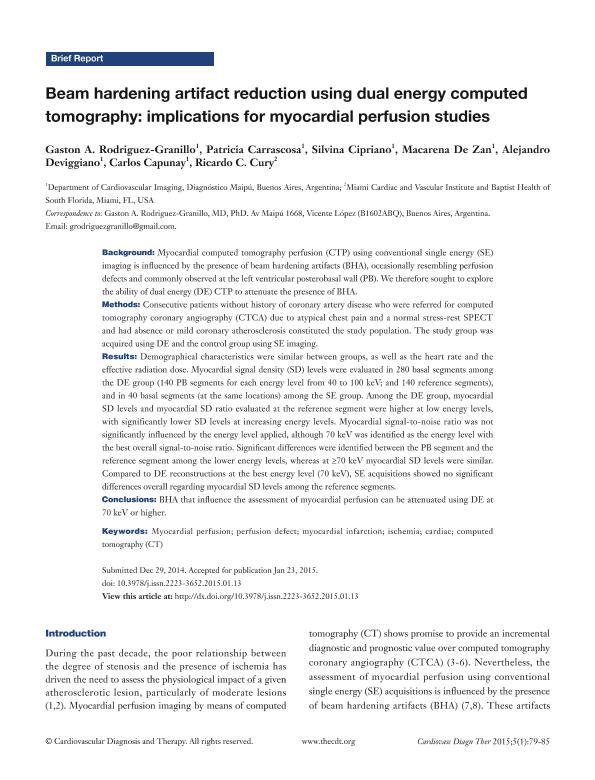Mostrar el registro sencillo del ítem
dc.contributor.author
Rodriguez Granillo, Gaston Alfredo

dc.contributor.author
Carrascosa, Patricia
dc.contributor.author
Cipriano, Silvia
dc.contributor.author
De Zan, Macarena
dc.contributor.author
Deviggiano, Alejandro
dc.contributor.author
Capunay, Carlos
dc.contributor.author
Cury, Ricardo C.
dc.date.available
2018-07-17T18:23:27Z
dc.date.issued
2015-02
dc.identifier.citation
Rodriguez Granillo, Gaston Alfredo; Carrascosa, Patricia; Cipriano, Silvia; De Zan, Macarena; Deviggiano, Alejandro; et al.; Beam hardening artifact reduction using dual energy computed tomography: implications for myocardial perfusion studies; AME Publishing; Cardiovascular Diagnosis and Theraphy; 5; 1; 2-2015; 79-85
dc.identifier.issn
2223-3652
dc.identifier.uri
http://hdl.handle.net/11336/52461
dc.description.abstract
Background: Myocardial perfusion computed tomography (CTP) using conventional single energy (SE) imaging is influenced by the presence of beam hardening artifacts (BHA), occasionally resembling perfusion defects and commonly observed at the left ventricular posterobasal wall (PB). We therefore sought to explore the ability of dual energy (DE) CTP to attenuate the presence of BHA. Methods: Consecutive patients without history of coronary artery disease who were referred for computed tomography coronary angiography due to atypical chest pain and a normal stress-rest SPECT and had absence or mild coronary atherosclerosis constituted the study population. The study group was acquired using DE and the control group using SE imaging. Results: Demographical characteristics were similar between groups, as well as the heart rate and the effective radiation dose. Myocardial signal density (SD) levels were evaluated in 280 basal segments among the DE group (140 PB segments for each energy level from 40 keV to 100 keV; and 140 reference segments), and in 40 basal segments (at the same locations) among the SE group. Among the DE group, myocardial SD levels and myocardial SD ratio evaluated at the reference segment were higher at low energy levels, with significantly lower SD levels at increasing energy levels. Myocardial signal-to-noise ratio was not significantly influenced by the energy level applied, although 70 keV was identified as the energy level with the best overall signal-to-noise ratio. Significant differences were identified between the PB segment and the reference segment among the lower energy levels, whereas at ≥ 70 keV myocardial SD levels were similar. Compared to DE reconstructions at the best energy level (70 keV), SE acquisitions showed no significant differences overall regarding myocardial SD levels among the reference segments. Conclusions: Beam hardening artifacts that influence the assessment of myocardial perfusion can be attenuated using DE at 70 keV or higher.
dc.format
application/pdf
dc.language.iso
eng
dc.publisher
AME Publishing
dc.rights
info:eu-repo/semantics/openAccess
dc.rights.uri
https://creativecommons.org/licenses/by-nc-sa/2.5/ar/
dc.subject
Myocardial Perfusion
dc.subject
Perfusion Defect
dc.subject
Myocardial Infarction
dc.subject
Ischemia
dc.subject
Cardiac
dc.subject
Computed Tomography
dc.subject.classification
Medicina Critica y de Emergencia

dc.subject.classification
Medicina Clínica

dc.subject.classification
CIENCIAS MÉDICAS Y DE LA SALUD

dc.title
Beam hardening artifact reduction using dual energy computed tomography: implications for myocardial perfusion studies
dc.type
info:eu-repo/semantics/article
dc.type
info:ar-repo/semantics/artículo
dc.type
info:eu-repo/semantics/publishedVersion
dc.date.updated
2018-07-05T13:12:30Z
dc.journal.volume
5
dc.journal.number
1
dc.journal.pagination
79-85
dc.journal.pais
China

dc.description.fil
Fil: Rodriguez Granillo, Gaston Alfredo. Consejo Nacional de Investigaciones Científicas y Técnicas. Oficina de Coordinación Administrativa Houssay. Instituto de Investigaciones Cardiológicas. Universidad de Buenos Aires. Facultad de Medicina. Instituto de Investigaciones Cardiológicas; Argentina. Diagnóstico Maipú; Argentina
dc.description.fil
Fil: Carrascosa, Patricia. Diagnóstico Maipú; Argentina
dc.description.fil
Fil: Cipriano, Silvia. Diagnóstico Maipú; Argentina
dc.description.fil
Fil: De Zan, Macarena. Diagnóstico Maipú; Argentina
dc.description.fil
Fil: Deviggiano, Alejandro. Diagnóstico Maipú; Argentina
dc.description.fil
Fil: Capunay, Carlos. Diagnóstico Maipú; Argentina
dc.description.fil
Fil: Cury, Ricardo C.. Miami Cardiac and Vascular Institute and Baptist Health; Estados Unidos
dc.journal.title
Cardiovascular Diagnosis and Theraphy
dc.relation.alternativeid
info:eu-repo/semantics/altIdentifier/url/http://cdt.amegroups.com/article/view/5699/6490
dc.relation.alternativeid
info:eu-repo/semantics/altIdentifier/doi/https://dx.doi.org/10.3978/j.issn.2223-3652.2015.01.13
Archivos asociados
